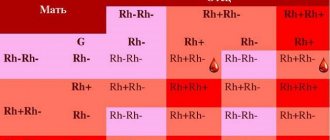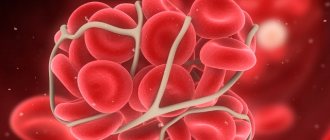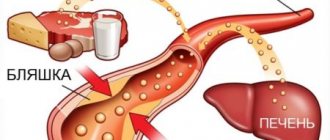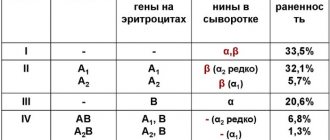Blood group compatibility is one of the most important problems not only of modern genetics as a science, but also of many married couples. When planning a child, it is necessary to take into account not only the moral and material aspects of the existing family, but also biological indicators, which bear the bulk of the difficulties that arise during pregnancy. In ordinary circles, it is believed that incompatibility of blood groups can result in improper development of the embryo and a difficult pregnancy for the mother.
What is the compatibility of parental blood groups for conceiving a child?
The genetic parameters of the parents' blood form a set of genes for inheritance by the fetus that is formed during conception.
The group and Rh factor are constant throughout life, so a preliminary study before pregnancy allows you to identify possible conflicts in advance.
When planning a pregnancy, parents have the opportunity to calculate their blood compatibility options. If the percentage of absence of any blood conflict is high, then for future parents, conception and the pregnancy period will proceed as normal.
Compatibility
Blood compatibility is a match by group and Rh factor
This criterion is very important when transfusing vital fluid, as well as during pregnancy planning and gestation.
What blood type will the child have?
The science of genetics provides for the inheritance of group affiliation and rhesus by children from their parents. Genes transmit information about the composition of blood cells (agglutinin alpha and beta, antigens A, B), as well as Rh.
Table "Inheritance of blood groups"
| Parents | Child | |||
| Blood groups, % | ||||
| 1 | 2 | 3 | 4 | |
| 1+1 | 100 | |||
| 1+2 | 50 | 50 | ||
| 1+3 | 50 | 50 | ||
| 1+4 | 50 | 50 | ||
| 2+2 | 25 | 75 | ||
| 2+3 | 25 | 25 | 25 | 25 |
| 2+4 | 50 | 25 | 25 | |
| 3+3 | 25 | 75 | ||
| 3+4 | 25 | 50 | 25 | |
| 4+4 | 25 | 25 | 50 |
Mixing groups of erythrocytes with different Rh leads to the fact that the child’s Rh factor can be either “plus” or “minus”.
- If Rh is the same between spouses (group D antibodies are present), 75% of children will inherit the dominant protein, and 25% will be absent.
- In the absence of specific protein D in the membranes of the mother’s and father’s red blood cells, the child will also be Rh negative.
- In a woman Rh-, and in a man Rh+ - the combination suggests the presence or absence of Rh in the child in a 50 to 50 ratio, with a possible conflict between the antigen of mother and baby.
- If the mother has Rh+ and the father does not have anti-D, there is a 50/50 chance that Rh will be passed on to the baby, but there is no risk of antibody conflict.
Important! It is important to understand that the Rh factor is transmitted at the genetic level. Therefore, if the parents are Rh-positive, and the child was born with Rh-, men should not rush to question their paternity
Such people simply have a person in their family without the dominant protein D in their red blood cells, which is what the baby inherited.
Blood type for transfusion
When performing blood transfusion (blood transfusion), it is important to maintain the compatibility of antigen and rhesus groups. Experts are guided by the Ottenberg rule, which states that the donor’s blood cells should not stick together with the recipient’s plasma.
In small doses, they dissolve in a large volume of the patient’s biological material and do not precipitate. This principle applies to transfusions of vital fluid up to 500 ml and is not suitable when a person has severe blood loss.
People with group zero are considered universal donors. Their blood suits everyone.
Representatives of the rare 4th class are suitable for blood transfusion of 1st, 2nd and 3rd types of blood fluid. They are considered universal recipients (people who receive blood infusions).
For patients with 1 (0) positive, class 1 (Rh+/-) is suitable for transfusion, while a person with negative Rh can only be given a zero with Rh-.
For people who have 2 positive, 1 (+/-) and 2 (+/-) are suitable. Patients with Rh- can only use 1 (-) and 2 (-). The situation is similar with 3rd grade. If Rh+ – you can pour in 1 and 3, both positive and negative. In the case of Rh-, only 1 and 3 without anti-D are suitable.
Compatibility at conception
When planning a pregnancy, the combination of the Rh factor of a man and a woman is of great importance. This is done to avoid Rh conflict. This happens when the mother has Rh-, and the child inherits Rh+ from the father. When a dominant protein enters a person’s blood where it is not present, an immunological reaction and the production of agglutinins may occur. This condition provokes the adhesion of the resulting red blood cells and their further destruction.
Blood compatibility chart for conceiving a child
Incompatibility of Rhesus of mother and child during the first pregnancy does not pose any danger, but before the second conception it is better to interrupt the production of anti-Rhesus bodies. The woman is injected with a special globulin, which destroys immunological chains. If this is not done, Rh conflict can provoke termination of pregnancy.
What is incompatibility
Incompatibility is a conflict between the mother’s body and the fertilized egg, which manifests itself from the moment of conception in the reaction of the mother’s body to the embryo as a foreign object. The mother's reproductive system teams up with the immune system to fight the embryo and tries to deprive it of life support, ultimately getting rid of it.
The classification of blood groups into first, second, third and fourth is based on the content of agglutinins in plasma and agglutinogens in erythrocytes. The Rh factor is the presence (positive) or absence (negative) of a protein antigen on the membrane of red blood cells, the most common of which is type D antigen.
When it happens
This conflict appears in two categories of cases:
- when the mother’s blood group does not match that of the fetus
- in the situation of an Rh-negative mother pregnant with an Rh-positive child.
Anti-D immunoglobulin
It is a prophylactic drug necessary to stop the mother’s body from producing antibodies that fight the Rh-positive embryo. The administration of the drug allows you to maintain pregnancy and prevent possible pathologies of the mother and child.
The use of immunoglobulin is prescribed by a doctor according to an individual regimen and implies:
- monthly check-ups up to 30 weeks
- once every two weeks from 30 to 36 weeks
- once a week from 36 weeks until delivery.
Also, prophylactic administration of anti-rhesus is carried out immediately after childbirth, which helps prevent conflict in possible future pregnancies.
Is pregnancy and childbirth possible?
Modern medical technologies make it possible to maintain pregnancy in any conflict.
Conception planning is the greatest help, since the attending physician is aware in advance of the risks of incompatibility, which allows him to select a pre-treatment regimen and subsequent pregnancy management. During the gestation period, the problem of incompatibility is concentrated on measures that prevent the mother's immune system from reacting to the fetus.
During childbirth, incompatibility results in health problems for the baby, which are dealt with by a neonatologist after birth.
Dangerous moments
The greatest danger to the fetus is Rh conflict. The maternal body regards the antigen protein as a microorganism that poses a threat, and directs the activity of all systems to produce antibodies. They subject the fetus to an attack designed to get rid of it as soon as possible, which often ends in pregnancy failure, fetal death and miscarriage.
If mother and fetus are incompatible, the most dangerous development option is hemolytic disease of the embryo, which leads to an abnormal increase in the size of the child’s liver, jaundice, and developmental delays due to insufficient blood supply to the brain.
Bottom line
To summarize, it must be said that blood group AB0 and Rhesus are 2 combined systems that provide the most accurate information about the functional characteristics of antigens on the surface of red blood cells. The AB0 system is based on the content of agglutinins in the plasma that are consistent with erythrocytes. The Rh system is a kind of addition to the main one; it is based on the study of the most active antigens in the blood and their presence.
Incompatible groups began to be considered those in which, as a result of interaction, opposition of antibodies and antigens occurs.
This is important for pregnancy and the subsequent growth of the child, since due to the constant multiplication of antibodies, Rh conflicts, hypoxia, hydrops fetalis, hemolytic disease, etc. can develop. Spontaneous abortion often occurs.
Possible problems can be prevented by the administration of anti-Rhesus immunoglobulin or intrauterine blood transfusion. Before planning a conception, we recommend consulting a doctor who will conduct an in-depth blood test and tell you how to act in case of incompatibility based on individual indicators.
Blood type or Rh factor is more important for pregnancy
It is impossible to choose the only important factor, because the incompatibility of partners for a healthy pregnancy cannot be accurately predicted, or whether the likelihood of conflict can be assessed. Pregnancy of an Rh-negative mother with an Rh-positive child requires the strictest medical control.
However, maternal-fetal blood group conflict is more difficult to track because it occurs in the first days after conception. Then a miscarriage may occur, which will go unnoticed by the couple (like another menstruation) and will not provide information about what happened for further pregnancy planning.
Character traits
People with the second blood group are peaceful, non-conflict, calm, balanced, flexible in communication and able to make concessions. They like a comfortable, safe and cozy environment without sudden changes.
Flexibility in communication
The character traits of people with the second positive blood group predetermine their frugality, tendency to save and the ability to organize their own business, competently manage the household, and work on the land. Those with the second blood type can be slightly stubborn and overly conservative. It is believed that people of blood type 2 have good contact with people of all other types of blood groups, except for the fourth.
Same blood types: compatibility
When a couple with the same blood groups plans a pregnancy, the child is protected from incompatibility.
If the parental blood groups match, the fetus has several inheritance options, but all of them are safe and completely compatible.
The only obstacle to successful conception can only be the Rh factor of the partners, which must be monitored even at the stage of pregnancy planning.
I+I
Parents with the first blood groups transfer to the gene pool of their future children a set of proteins only for this group. This means that the child will definitely inherit the first group.
II+II
Parents with the second blood group have a chance of conceiving both a child with the same group and with the first. In the first case, the probability of inheriting the second blood group is 94%, while the first is only 6%. In both cases, there will be no conflict.
III+III
Parents with third blood groups are 94% likely to pass it on to their child. However, there is a 6% chance of conceiving a fetus of the first group.
IV+IV
The greatest range of possible blood types of the unborn baby is found in partners with fourth blood groups. Such couples can also conceive a child with the fourth group in 50% of cases, with the second - in 25%, with the third - in 25%.
Determining the blood of the unborn child
Of course, this does not apply to the question of which blood groups are compatible and which are not; we found that this parameter does not affect the likelihood of conceiving a baby at all. But I’m still curious what blood type the child will inherit. The table below will help you figure this out.
A curious situation arises for parents with groups II and III: their children can inherit any of the four types of systems. As for Rh, the baby will inherit Rh negative only if both parents “carry” Rh-, in other cases the chances are 50/50.
Probability of Rh conflict: incompatibility table
| Father's Rh factor | Mother's Rh factor | Rh factor of the child | Presence of Rh conflict |
| + | + | + | Absent |
| — | Absent | ||
| + | — | + | Present |
| — | Absent | ||
| — | + | + | Absent |
| — | Absent | ||
| — | — | — | Absent |
Rh incompatibility occurs only in cases where the mother’s negative Rh comes into conflict with the child’s positive Rh. Maternal blood, which does not contain an antigen protein, perceives the blood of the fetus as hostile due to the presence of D-antigen on its red blood cells. Such a Rh conflict is fraught with fetal rejection already in the very early stages of pregnancy.
In cases where a miscarriage does not occur, during the gestation period the embryo is constantly exposed to attacks by the immune cells of the mother’s body, which provokes the development of jaundice, anemia, and dropsy in the child.
Types of conflicts
There is also the concept of incompatible blood groups during pregnancy in mother and child, which can also lead to the development of conflict, but according to the ABO system.
This type of complication is as common as Rhesus incompatibility, but its consequences are less catastrophic. It can develop if the mother has blood type 1, that is, does not contain agglutinogens, and the child inherits any other group from the father, and accordingly his blood contains antigens A and B, both individually and together.
A conflict in the ABO system can develop even during the first pregnancy, but the fetus will not develop pathological conditions, and there will be no signs of anemia. But just as in the case of Rh-conflict, in the first days after birth the level of bilirubin in the child’s blood will be significantly increased and in order to eliminate the manifestations of pathological jaundice in him it will be necessary to carry out the same therapeutic measures as in the case of an isoimmune conflict for Rh- factor.
Rh factors of mother and child
The blood groups of the child and the mother may also be incompatible for the birth of a child if the expectant mother has a history of a disease such as thrombocytopenia, that is, a decrease in the number of platelets in her blood. In this case, the woman experiences the formation of antibodies directed against the platelets of the fetus.
Which group makes it difficult for a woman to get pregnant?
The process of fertilization of an egg by a sperm is not directly related to the characteristics of the blood of each parent. Conception occurs or not according to its own laws, which are separately diagnosed by a doctor and do not make a prognosis for the course of pregnancy. Difficulties in pregnancy are associated only with the gradually developing incompatibility of partners, which is revealed already during pregnancy.
First negative
A woman with a negative blood type has the most limited number of options for a safe pregnancy. Firstly, negative Rh is demanding of the same from the partner. Secondly, group I, which does not have protein tags, will conflict with male group II, III and IV, respectively producing antitags to proteins A, B and AB. A healthy pregnancy without worries about any incompatibility for women with I negative blood is promised by a partner who has exactly the same group.
In addition, repeated studies of female subjects aged 35 years have shown that it is the owners of group I who have increased levels of follicle-stimulating hormone, which indicates a rapid depletion of the ovarian reserve.
Second negative
It has type A antigen, which indicates a probable conflict with the blood of men of groups III and IV. Positive Rh in your partner can aggravate a planned pregnancy.
Third negative
Statistically, the blood group is the rarest, so predicting conception and the course of pregnancy is highly individual. Contains type B protein, therefore for easy fertilization and gestation it requires a negative partner with group I or III.
Fourth negative
A rare blood group, which is associated with the greatest number of guesses and calculations, based more on rumors and superstitions than on scientific facts. In fact, type IV has AB tags, making it ideally compatible with any partner's blood type. Negative Rh requires standard accounting of the Rhesus of the man for all groups and therapy in the case of a positive spouse.
Advantages and disadvantages
The peculiarities of blood group A (2) include the fact that people who are its carriers have a strong immune system, which allows them to effectively fight bacteria and viruses. The most beneficial type of diet for them is vegetarianism. Characteristics of people with group A2:
- slow;
- weak-willed;
- conscientious about their work;
- executive;
- careful;
- love to analyze.
In professional activities, people with 2 negative blood groups, as well as positive ones, try to achieve a higher goal. But the disadvantages of such people include the fact that if a problem arises, they do not seek advice, but experience stress alone. Men and women love order, calm and harmony.
Important information: Diet (menu) for 4 positive (negative) blood group and food table for women
They are often donors, but they often undermine their health with poor nutrition. There is a special diet for such people, but failure to comply with it worsens the quality of the blood. The advantages of representatives with group A (2) include the fact that they have strong organs of the genitourinary system and liver. Disadvantages: predisposition to thyroid diseases, gastritis, heart disease, caries.
Positive group in a woman
Women with a positive blood type do not have to worry about Rh conflict. The presence of a protein antigen in their blood allows them to easily conceive and bear a child with any Rh factor inherited from both parents.
This happens due to the fact that the body, encountering the antigen for the first time, will try with all its might to overcome it and remove it from its blood system.
In the blood of a positive Rh factor, the protein is already present and is easily recognized by the maternal body in the fetus, if any. If the fetus inherits Rh negative, then the mother’s immunity simply has nothing to react to, and the pregnancy proceeds well.
Diet
People with a second positive blood group need to adhere to certain dietary rules that will have a beneficial effect on the condition of the body. It is important to get the maximum amount of vitamins and minerals from foods for the normal functioning of all organ systems.
It should be remembered that there are foods that are contraindicated for carriers of the second blood group due to their susceptibility to diseases (for example, too fatty foods can cause gastritis or obesity).
Let's take a closer look at healthy and harmful foods.
Healthy foods
People with a positive blood group are genetically predisposed to vegetarianism. The basis of their diet should be vegetables and fruits.
Vegetables are a real storehouse of vitamins and minerals, an excellent source of fiber and organic acids. It must be remembered that when cooked, vegetables lose some of their beneficial properties, so it is advisable to eat them fresh. However, eating only raw vegetables is also not recommended, as this can negatively affect intestinal function.
People with a positive blood type are genetically predisposed to vegetarianism
The most useful vegetables for owners of the second positive blood group are cucumbers, bell peppers, carrots, beets, and broccoli. You can eat tomatoes, potatoes, white cabbage and eggplants in moderation.
Almost all fruits are healthy, except for the too sour ones - apples, peaches, apricots, kiwis, grapes, strawberries, cherries, currants, etc.
If you cannot completely eliminate meat from your diet, it is recommended to consume dietary types of it - chicken, turkey, rabbit. It is advisable to eat meat boiled, steamed or baked.
Fish will be useful for those with the second blood group, but again, with the exception of fatty varieties.
It is recommended to consume all types of cereals, especially rice, millet, buckwheat, barley and pearl barley.
Holders of the second group are recommended to consume all types of cereals
An excellent source of protein will be legumes - beans, lentils, soybeans.
Vegetable oils will be beneficial - flaxseed, olive, pumpkin, sesame.
For drinks, preference should be given to natural fruit juices, tea and coffee.
Harmful products
Since the gastrointestinal tract in people with a second positive blood group does not cope well with the digestion of meat products, any fatty varieties of meat - pork, lamb, etc. - are strictly contraindicated.
It is also worth excluding fatty fish varieties - cod, halibut, herring, mackerel, etc.
Due to the reduced acidity of the stomach, it is undesirable to include acidic foods in large quantities in the diet. All citrus fruits are contraindicated - lemons, oranges, tangerines, grapefruits.
All citrus fruits are contraindicated for people with blood type II.
It is undesirable to consume dairy products, as they slow down metabolism and can contribute to the development of obesity. In very small quantities you can eat hard cheese, low-fat cottage cheese and natural yogurt.
It is recommended to completely exclude any sauces - ketchup, mayonnaise, mustard, horseradish. Pickled vegetables and Korean salads are contraindicated.
You should also exclude all confectionery products - cakes, pastries, buns, sweets.
It is advisable to completely stop drinking alcohol, as it can cause disturbances in the functioning of the nervous system.
Video: 2nd blood group. Nutrition and disease
Positive blood type in a man
In the case of a male Rh positive, strict comparison with the group and Rh of the mother is necessary. The presence of Rh will not affect pregnancy if the partner is also Rh positive. If the mother’s body is unfamiliar with the Rh antigen, then possible fertilization with the development of a positive blood group in the fetus will lead to the mother’s womb causing rejection (miscarriage).
Therefore, in preparation for pregnancy, expectant fathers need to do an analysis to clarify the group and Rh (even if they are completely confident in their knowledge), so that in case of incompatibility they can take precautions in advance.
AB0 blood classification system
In 1900, the Austrian immunologist Landsteiner conducted a study which revealed that the blood of different people differs in the composition of antigens and antibodies to it.
The scientist came to the conclusion that the same blood never contains both antigens and antibodies of the same name. This discovery marked a new stage in the development of medicine, and Landsteiner was awarded the Nobel Prize for it.
Video about the second positive blood group
According to the AB0 classification, the blood group is named according to what antigen is present in it: in blood group 2, antigen A is present, therefore its designation according to this classification is A(II).
Classification of blood by groups
For reference. 30-40% of the world population have the second blood group.
Different blood types of parents: compatibility table
| Father's blood type | Mother's blood type | Child's blood type | Probability of conflict |
| First | Second | First or second | 0% |
| First | Third | First or third | 0% |
| First | Fourth | Second or third | 0% |
| Second | First | First or second | 50% |
| Second | Third | Any of the four | 25% |
| Second | Fourth | First or second or fourth | 0% |
| Third | First | First or third | 50% |
| Third | Second | Any of the four | 50% |
| Third | Fourth | First or third or fourth | 0% |
| Fourth | First | Second or third | 100% |
| Fourth | Second | First or second or fourth | ≈66% |
| Fourth | Third | First or third or fourth | ≈66% |
The table shows data on the probabilistic incompatibility of the mother’s blood group with the embryo’s blood group, based on data on the groups of both parents. Thus, pregnancy is complicated in cases where the child’s group is different from the mother’s group. At the stage of pregnancy planning, an accurate prediction of the type of the future embryo with different blood groups of the parents is impossible, therefore the consequences of the conflict are neutralized already during gestation.
The most common of these is hemolytic disease of the baby, which causes jaundice and increases bilirubin levels. Hemolytic disease is most severe when there is a conflict between the mother’s first blood group and the second or third fetus’s blood group.
Checking the compatibility of partners for conception: how to do it?
At the moment, modern medicine has “stepped far forward” and has a lot of ways to determine the compatibility of partners and find a solution to the problem of infertility. If you cannot get pregnant within 1 year, you should consult your doctor for an examination and he will prescribe you a series of important tests:
- Microflora analysis
- Blood analysis
- Hormonal analysis
- Analysis of the immune system
- Ultrasound
IMPORTANT: Do not be afraid of these examinations and laboratory tests, because they can not only study your level of health, but also determine possible diseases that your fetus can suffer.
How to get pregnant for a married couple if they are incompatible
The greatest difficulties in getting pregnant are faced by couples with different groups of mother and father in such variants as I+II, I+III and II+III. With this ratio, a fertilized egg can be rejected by the mother’s body within 3-4 days, so the woman does not have time to notice the pregnancy. To avoid miscarriage, pre-planned constant ultrasound monitoring of ovulation and fertilization is necessary.
It is impossible to maintain a pregnancy with blood group I in the mother and blood group IV in the father, since possible blood groups II or III of the embryo will be perceived by the maternal immune system as hostile. In this case, surrogacy technologies and the expectation of other innovations in medicine come to the aid of parents.
Immunological infertility and Rh incompatibility
It is worth remembering that immunological incompatibility and conflict of Rh factors are different concepts. With immunological infertility, contact of the immune system with germ cells occurs, which does not occur in a healthy man’s body, but in a woman’s body is subject to a natural process. If there is blood incompatibility, conception occurs normally, but problems arise during the development of the fetus.
Principles of partner compatibility
- In infertility, incompatibility is said to exist if the man and woman are immunologically incompatible. Blood type and Rh factor do not play a role in the process of conception. With immunological infertility, the female body produces antibodies to sperm.
- A woman with negative Rh is able to bear and give birth to a child with positive Rh. Complications during pregnancy and abnormalities in the child after birth are possible, but this phenomenon should not be mistaken for incompatibility for conception.
- A couple in which the Rh factors are different can have healthy children. In such a situation, the mother’s Rh will be key, and the child may well have the same Rh as her, which will not lead to conflict.
- If your partners are incompatible, follow all the doctors’ recommendations. It is often possible to compensate for the harm and deliver a healthy baby.
- A successful pregnancy with incompatible partners does not guarantee subsequent success. Each subsequent pregnancy increases the risk of incompatibility between mother and child. Often, during the first pregnancy, incompatibility does not appear. The next attempts may turn into a problem, because the woman’s body already has antibodies.
- With negative Rh in the mother and positive in the father, the probability of conflict during pregnancy is 50% (when the antigen is encoded on each of the chromosomes in a pair) and 25% (when the antigen is encoded on one of the chromosomes in the pair).
- Women with positive Rhesus never have a conflict with the blood of the fetus.
- Conflict can only happen if the mother is Rhesus negative. The maximum probability is 50%.
- The formation of the Rh factor in the fetus depends on the Rhesus of the parents and genes that were passed on but never manifested.
Partner analysis to determine compatibility
As a rule, the initial stage of compatibility testing involves determining the main indicators of partners in the clinic. Based on the data, a prediction is made about a possible conflict between groups or Rh factors. At this stage, analysis indicators provide information only about probabilistic incompatibility, which may not occur. If during pregnancy the fact of incompatibility between the fetus and the maternal body is confirmed, then the necessary drug therapy is selected individually by the doctor.
What is incompatibility between spouses when conceiving a child based on microflora, how is it treated?
Each person has his own microflora in the reproductive system (balance of beneficial bacteria). In addition to bacteria, pathogenic microorganisms (microbes) may also be present, which can interfere with favorable conception. The number of these microorganisms is regulated by the immune system, and therefore if a woman has a weak immune system, it will be difficult for her to conceive.
IMPORTANT: If a couple has microflora incompatibility, this will be a clear threat to conception, because as long as it exists, the immune system will protest conception in every possible way.
You can notice the symptoms of pathogenic microflora immediately after sexual intercourse:
- Burning in the groin
- Itching in the groin
- Unpleasant sour odor from the external genitalia.
- Strange mucous discharge that may be copious.
- Frequent thrush in women
IMPORTANT: Infertility due to impaired microflora of a woman or man is detected in only 3% of cases and it is successfully treated with modern medicine.
Infertility due to incompatibility of the microflora of the genital organs
Solving the problem in the presence of blood conflict
Modern medicine offers several essentially different options for maintaining pregnancy in case of incompatibility of any type. Timely examination at the planning stage and regular visits to the doctor managing the pregnancy can minimize the risks of complications.
Plasmapheresis
The procedure for purifying maternal blood plasma from antibodies and its possible replacement with sterile or vitamin solutions. Plasmapheresis is carried out at different stages:
- When planning pregnancy to cleanse the body of toxins and antibodies;
- In the initial detection of Rh conflict, when replacing about 30% of the plasma with saline or albumin solution makes the development of the embryo safe;
- With a sharp increase in the level of antibodies in the mother’s blood, diagnosed at any stage of pregnancy.
Blood transfusion
It is the process of blood transfusion to a fetus inside the womb for a period of 22 weeks. In this case, blood is taken of the same type as that of the child, and must be Rh negative. The procedure is performed through the umbilical vein under ultrasound guidance and is designed to stop the baby from being rejected by the mother's immune system.
The main indications for transfusion are:
- Polyhydramnios;
- Detection of fluid in the child on an ultrasound of the abdominal cavity or an increased size of the liver;
- Thickening of the placenta;
- Change in the diameter of the umbilical veins.
Induction of labor
If, when a blood conflict is detected, the number of antibodies is low, then preference is given to natural childbirth. Induction of labor or prescribing a cesarean section requires constant medical supervision during hospitalization. The amount of antigens is measured twice a day, and if the level is significantly higher than normal, labor is induced immediately. In this case, treatment of a newborn from the possible consequences of a conflict with maternal blood is carried out after birth.
ABO and RH system
The set of antigens found on red blood cells determines membership in one group or another. In fact, doctors know about 400 antigens, and therefore there are quite a few classifications. However, the properties of most antigens are weakly expressed and are not taken into account during transfusion
During blood transfusions, the greatest attention is paid to the AB0 and Rh systems
According to the AB0 system, blood is divided into four groups. The first has neither one nor the other antigen, the second has only A, the third has B, the fourth has both antigens - A and B. Natural antibodies (agglutinins) are present in the plasma - anti-A and anti-B (α and β ). Only opposite antigens and antibodies can be present in the blood. The first contains anti-A and anti-B, the second contains anti-B (β), the third contains anti-A (α), and there are no antibodies in the plasma of the fourth.
The table clearly demonstrates this.
| Group | Agglutinogen in red cells | Agglutinin in plasma |
| I | absent | anti-A and anti-B |
| II | A | anti-B |
| III | B | anti-A |
| IV | AB | absent |
According to the Rh system, blood can be Rh positive or Rh negative. This depends on the presence of a specific Rh factor antigen on the surface of red cells. If the blood of the donor and the patient belongs to the same group, but one is Rh-positive and the other is Rh-negative, incompatibility occurs.
According to the AB0 system, blood is divided into four groups. The first has neither one nor the other antigen, the second has only A, the third has B, the fourth has both antigens - A and B. Natural antibodies (agglutinins) are present in the plasma - anti-A and anti-B (α and β ). Only opposite antigens and antibodies can be present in the blood. The first contains anti-A and anti-B, the second contains anti-B (β), the third contains anti-A (α), and there are no antibodies in the plasma of the fourth. The table clearly demonstrates this
Prognosis for bearing a child
Developments in modern medicine offer more and more innovations in the field of reproductive medicine - precision equipment, analyzes of necessary samples, IVF procedures, etc.
Timely selection by a doctor of a set of means to neutralize parental incompatibility can guarantee the desired pregnancy.
Numerous treatment options based on the artificial introduction of immunoglobulin into the mother's body are designed to avoid pregnancy fading or miscarriage. This procedure allows you to maintain pregnancy and make it easier.
If a parental blood conflict is diagnosed, it is necessary to strictly follow the examination plan and strictly follow medical recommendations.
Incompatibility of partners can be hidden both in psychological reasons and can be predicted in advance using tests at the stage of preparation for conception. About 15% of couples are faced with the problem of the impossibility of a successful pregnancy due to Rhesus conflict of partners. However, early medical control and a responsible approach to the necessary procedures provide a high chance of a healthy pregnancy.
Treatment of incompatibility for conception
What to do with Rhesus conflict?
When conception has occurred and there is Rh factor incompatibility, the woman has to be under close supervision all the time. If experts consider the existing circumstances of Rh conflict dangerous, then the administration of immunoglobulin is prescribed. This may be needed at 28 weeks of gestation. The procedure is repeated on the third day of the born child’s life. Certain situations of Rh factor incompatibility imply a way out of a dangerous situation in the form of a blood transfusion.
Overcoming immunological incompatibility
New medical technologies make it possible to get rid of the problem of immunological incompatibility, and this provides families with the opportunity to have children. Therapy is prescribed by a doctor. In most cases, incompatibility disappears when conceiving a child; this process is improved after a correctly completed course of antihistamines. In some situations, everything is decided by a temporary measure - eliminating the woman’s contact with sperm. This is achieved through the use of condoms. Sometimes this approach provokes an increase in the female body’s sensitivity to male sperm.
Treatment with immunosuppressive drugs that suppress immune activity is also often used. In other cases, the introduction of immunostimulants helps. Sometimes the problem is solved by injecting male sperm directly into the uterine cavity. These treatment methods are used separately or in combination.
An innovative method is the introduction of lymphocytes taken from the spouse into the woman’s subcutaneous space. A positive effect can be expected from such a procedure. That is, the expectant mother’s immune system is functioning normally, and the body is adjusting to the upcoming pregnancy.
Do not despair if you are diagnosed with incompatibility during conception and cannot achieve pregnancy. By following medical instructions, many couples manage to achieve the desired birth of a new life. It is worth considering that modern developed medicine is capable of much.
At this stage, healthy parents almost never think about the fact that something could go wrong. After 1-2 years of unsuccessful attempts and health checks, doctors make a disappointing verdict: immunological infertility. Let's find out in more detail why incompatibility of partners occurs during conception, the signs of this condition and what to do about it.











